The Lunar New Year (Tết Nguyên Đán) is considered the oldest festival in Vietnamese history. This is a time for families to gather, relax, and celebrate after a year of hard work. However, Vietnam is not alone; many countries around the world also celebrate the Lunar New Year.
Top 12 Countries and Territories Celebrating Lunar New Year Like Vietnam
1. China
Like Vietnam, the traditional New Year in China is the biggest and most important festival of the year.
This is an occasion for families to reunite and welcome the new year together, which is why from the 8th day of the 12th lunar month, Chinese people around the world return to their hometowns to celebrate the New Year.
The joyful traditional festivals in China last until the end of the 15th day of the first lunar month.
To wish for good fortune in the new year, Chinese people often decorate their homes by hanging red couplets, red lanterns, and pasting red paper, as well as hanging the character “Fu” upside down, symbolizing “Fu Dao” (Luck has arrived). Visitors to China during the Lunar New Year will be greeted by this warm and vibrant color.
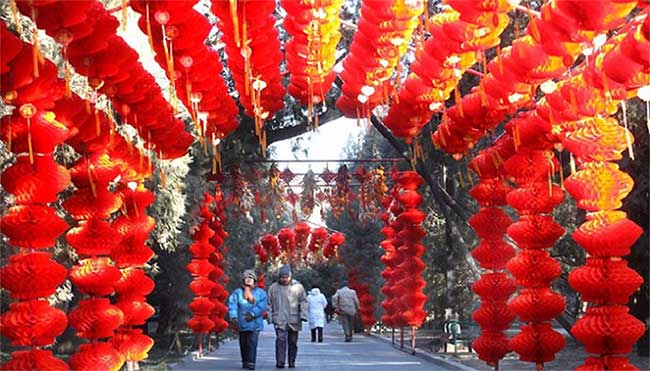
Chinese streets adorned beautifully. (Photo: Globe Trottr).
On New Year’s Day, Chinese people also have a tradition of gathering to prepare delicious dishes to honor their ancestors.
Each year in the Chinese calendar corresponds to a specific animal, so during the year of that animal, people usually avoid eating that animal’s meat at the start of the year.
The New Year’s menu for Chinese people primarily consists of various types of cakes.
No New Year’s meal is complete without dumplings (sủi cảo), a traditional dish of the Chinese. This dish is considered lucky during the new year since the dumplings resemble gold ingots used in ancient times. Many families even place coins inside the dumplings before steaming them. If someone bites into the dumpling with the coin, they are believed to have good luck for the entire year.
Additionally, there is Nian Gao, a cake made from high-quality glutinous rice, sugar, and a bit of fresh ginger.
In Chinese, “Gao” means cake, and “Nian” means sticky, which signifies glutinous rice cake. People consume this cake with the hope that family members will always remain closely bonded.
The transliteration “Nian Gao” in Chinese also conveys the meaning of prosperity, progress, and continual advancement, which is the wish of everyone for the new year.
During this time, people visit each other to talk about the past year, exchange “hong bao” (red envelopes containing money), and share good wishes.
2. Cambodia
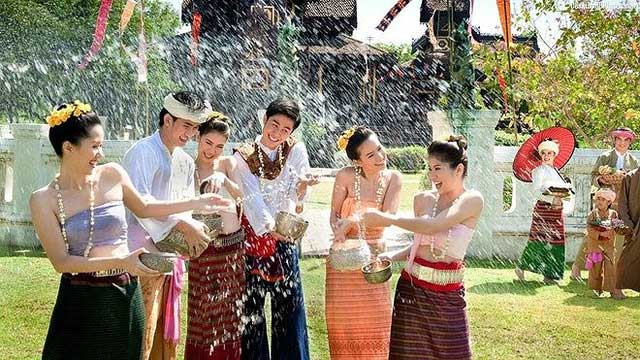
The Lunar New Year in Cambodia is celebrated with a grand festival known as Chol Chnam Thmay.
The Cambodian people, or Khmer in Vietnam, celebrate Chol Chnam Thmay with great enthusiasm. They believe that each year a deity is sent down to oversee life for that year, and at the end of the year, another deity takes over.
3. Thailand
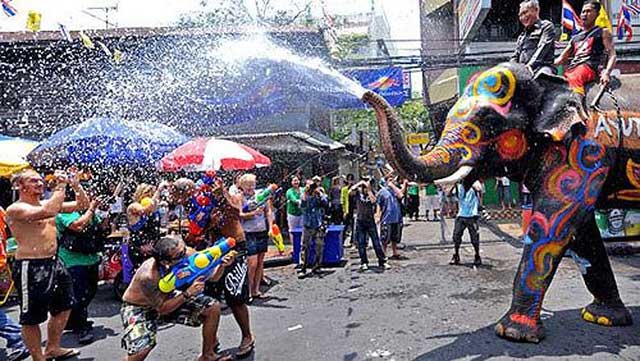
In the Land of Smiles, Thailand, people celebrate the Lunar New Year for three days, similar to Vietnam. The biggest festival during this time is called Songkran, occurring from April 13 to April 15. During this festival, the custom of pouring water takes place, where younger people pour water over the elderly as a sign of respect, while the elderly hope that their younger counterparts will forgive their daily harsh words.
This water-pouring custom is particularly grand and has attracted many tourists, who enjoy using buckets, basins, water balloons, and water guns to splash each other. Those who get splashed the most are believed to be lucky for the entire year.
4. Taiwan (China)

People in Taiwan view this as the biggest holiday of the year, a time for families to gather around the dining table to share their joys, sorrows, successes, and failures from the past year.
The importance of family reunions during the New Year in Taiwan is so significant that if a family member arrives late or cannot return, they will still reserve a seat for them.
5. Singapore
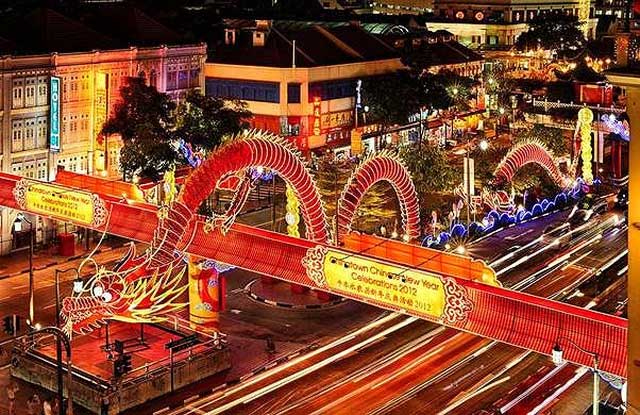
Being a country with a majority Chinese heritage, Singapore’s culture is heavily influenced by Chinese traditions. The Lunar New Year in Singapore is celebrated almost simultaneously with Vietnam (on the 1st day of the 1st lunar month).
People decorate their homes and streets in the characteristic red of the New Year to welcome the new year. Numerous festivals take place throughout the month from the 1st day of the lunar month until mid-February, including the Lantern Festival, Singapore River Hongbao Festival, and Chingay Parade.
Among these, the most vibrant and widely participated event is the Chingay Parade (meaning “the art of costume and masquerade” in Chinese), usually held from the first Saturday of the new year in the Marina Bay area and concluding on the 15th day of the lunar month. This unique event attracts many tourists and locals to participate in the street parade, helping to strengthen solidarity among ethnic groups in the country and with communities worldwide.
6. Mongolia

Tsagaan Sar or the White Month is the term used by Mongolians to refer to their Lunar New Year. Tsagaan Sar signals the arrival of spring, marking the end of a harsh winter in the region, a warm time suitable for starting a new farming season.
Families gather together to enjoy a warm family meal. The elderly will give gifts to the children, similar to the practice of giving red envelopes during Tết in Vietnam. Beautifully arranged fruit trays are offered to ancestors.
The Mongolian New Year meal includes unique dishes such as rice with curd, rice with raisins, and roasted lamb, all of which carry the wild flavors of Mongolia.
7 – 8. South Korea – North Korea

Having a common ancestry, it is understandable that these two countries celebrate the Lunar New Year on the first day (North Korea has shifted its celebrations from October and November to the 1st day of the 1st lunar month in recent years). Although there are many different customs on New Year’s Day, the tradition of family gatherings remains quite similar.
The traditional New Year dish in South Korea is ttok-kuk (a soup made from beef or chicken), along with spicy kimchi and rice cake soup. South Koreans believe that eating ttok-kuk will add a year to their age.
In North Korea, they have “medicine rice,” which is an essential dish on the altar for ancestor worship and to serve guests at the beginning of the year. North Koreans believe that eating this rice at the start of the new year will ensure a year of abundance and sweetness.
9. India
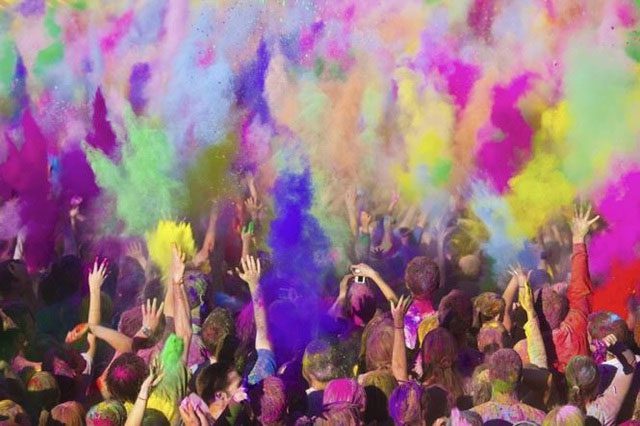
The biggest lunar festival in India is Holi. This is considered the most important festival of the year and is a famous spring festival for the Indian people.
This festival marks the end of the harsh winter and welcomes spring, characteristic of the New Year. Moreover, the Indians believe that when the sun warms up and dispels the cold of winter, it is akin to good triumphing over evil.
Similar to Thailand’s water-splashing festival, in India, people throw colored powder and water on each other, regardless of whether they are familiar or strangers. Along with various other impressive festive activities, this event leaves a significant impression on tourists who participate in the celebration.
10. Bhutan
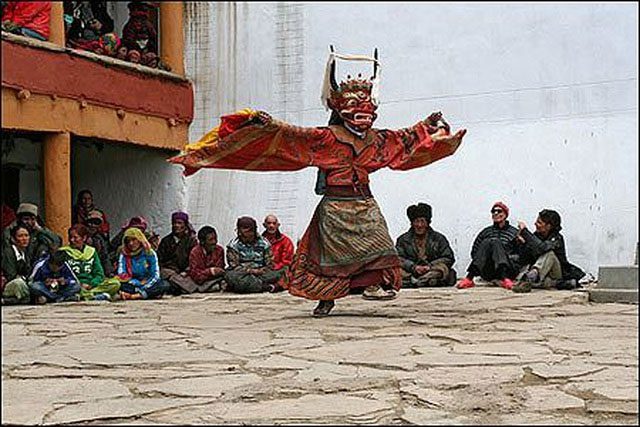
Bhutan’s holiday and New Year celebrations are quite similar to Vietnam. The people of Bhutan refer to this string of days as Tết Losar. This is the most important festival of the year, calculated according to the lunar calendar, lasting for 15 days, with the first three days marking the new year.
Every family member returns home, no matter how far away, to clean the house together, arrange offerings of food, and display fruit to honor their ancestors. This is a tradition observed by the Bhutanese people. The lavish meals, abundant with food and fruits, are prepared to express gratitude to the deities and ancestors for the blessings of a prosperous life in the past year.
11. Malaysia

The New Year in Malaysia begins on January 1st (according to the Islamic calendar). Homes are thoroughly cleaned and decorated, and the streets are adorned with vibrant colors.
About ten days before the New Year, Malaysians practice fasting as a way to empathize with the suffering of the poor, in accordance with the teachings of Allah.
A popular dish during Malaysia’s New Year celebrations is called Otak – Otak, also known as Otah – Otah. Tourists can easily find this dish anywhere, from city food centers to large restaurants and family meals.
During New Year gatherings, Malaysians have a tradition of gently touching their palm to the palm of the person opposite them, then retracting their hand and placing it close to their heart for a few seconds.
12. Tibet
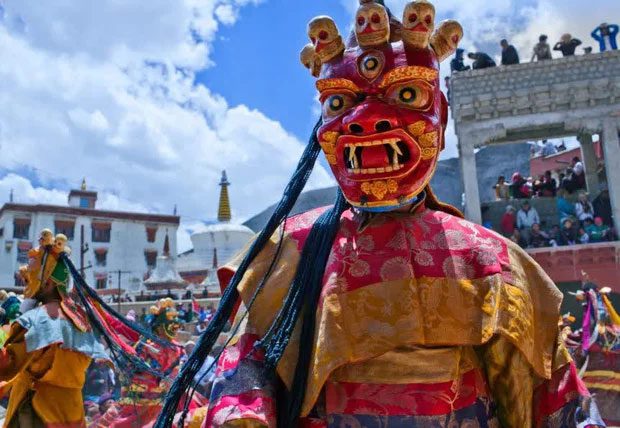
The Tibetan people do not use the Gregorian or lunar calendars; instead, they have their own unique way of counting days called the Tibetan calendar. This calendar is similar to the lunar calendars of some other countries that also celebrate the New Year.
During the last two days of the old year, known as Gutor, Tibetans begin preparing for the Tibetan New Year. The celebration of Losar starts on the 29th day of the 12th month of the Tibetan calendar, one day before the Tibetan New Year’s Eve. On this day, monasteries hold special ceremonies to prepare for the Losar festival.
A traditional Tibetan dish is Guthuk soup. Guthuk soup is typically made from meat, dried cheese, white radish, and large Tibetan-style noodles. Tibetans eat the soup while setting off firecrackers and waving straw torches to drive away evil spirits. Incense is offered to the deities, alongside colorful prayer flags that symbolize peace, compassion, and wisdom.


















































